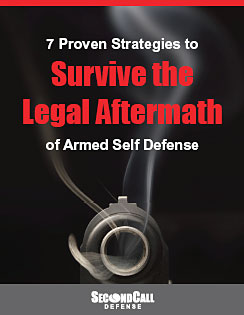How to Avoid Negligent Discharges – Part 1
by Sean Maloney
I recently received three phone calls from gun owners who experienced negligent discharges. This prompts me to remind us all about the importance of
fundamental rules of gun safety.
I will not get into the pending legal implications for each case. I want to focus on safety.
Thankfully, there were no injuries in any of the three incidents, but that was just blind luck.
For some time I have been concerned that the more we carry and get comfortable with our firearms, the more susceptible we become to inadvertent violations of safe gun handling rules. After interviewing the individuals involved in these negligent discharges, I am convinced that the handling of firearms became automatic, rather than a deliberate action.
Each time we handle a firearm, we must be acutely aware of the direction the muzzle is pointing and the location of our trigger finger. I assure you, if the first two rules of safe gun handling were followed, none of these negligent discharges would have occurred.
In each case, the negligent discharge happened after the firearms were field stripped, cleaned, reassembled, and reloaded for self-protection in the home. The firearms involved included two semi-automatic pistols and one modern sporting rifle.
Before I detail each negligent discharge, let’s review the rules for safe gun handling:
ALWAYS keep the gun pointed in a safe direction.
This is the primary rule of gun safety. A safe direction means that the gun is pointed so that even if it were to go off, it would not cause injury or damage. The key to this rule is to control where the muzzle is pointed at all times. Common sense dictates the safest direction, depending on different circumstances.
ALWAYS keep your finger off the trigger until ready to shoot.
When holding a gun, rest your finger along the side of the gun. Until you are actually ready to fire, do not touch the trigger.
ALWAYS keep the gun unloaded until ready to use.
Whenever you pick up a gun, immediately engage the safety device if possible, and, if the gun has a magazine, remove it before opening the action and looking into the chamber, which should be clear of ammunition.
These are the three primary rules for safe gun handling, but really, the first two are key, as you will see in my analysis of these three incidents.
Incident #1
In the first phone call I received, the gun owner informed me that after cleaning his pistol, he inserted a loaded magazine into the firearm and “racked” the slide, causing a round to be seated in the chamber, and promptly “chamber checked” the condition of the firearm.
After being satisfied that his firearm was ready to be fired, with a round in the chamber, he grabbed the hard side case the firearm was shipped in, and while in the process of placing the firearm in the case, it “went off.”
Thankfully he or anyone else was not killed or injured by the .40 caliber bullet that was negligently discharged.
He informed me that his finger “must” have been on the trigger when he was putting it into the case, “but I didn’t think about it, I was just putting it away.”
After the .40 caliber bullet left his firearm, it also left his house through the dining room wall, and lodged in his next-door neighbor’s family room wall. Luckily, nobody was home in his neighbor’s house. But can you imagine the shame and embarrassment of waiting for your neighbor to come home so you can explain the bullet hole through their exterior wall? Or the look of panic on your neighbors face when they realized any one of his family could have been killed?
If we always remain consciously aware of the direction the muzzle of any firearm, and always keep it pointed in a safe direction, then the result of our negligence is confined to our shame, embarrassment and feelings of stupidity. If we don’t control the muzzle, our negligence continues, and follows the “shot” we fired, intentionally or not. We “own” that bullet and any consequences that result from the actions of the local Prosecutor or Plaintiffs Attorney.
In this case, if his finger would have been consciously on the outside of the trigger guard, or along the slide, the shot would have never been fired.
Worst case scenario, if the muzzle of the firearm was pointed in a safe direction, the damage from the bullet “he owns” would have been confined to an area he controls. Instead of calling me, seeking legal representation, he probably would have called a contractor to repair the damage he caused. Now, instead, he is waiting for a call from the Prosecutor or a knock on the door.
In the next post, I’ll share the second two incidents.

